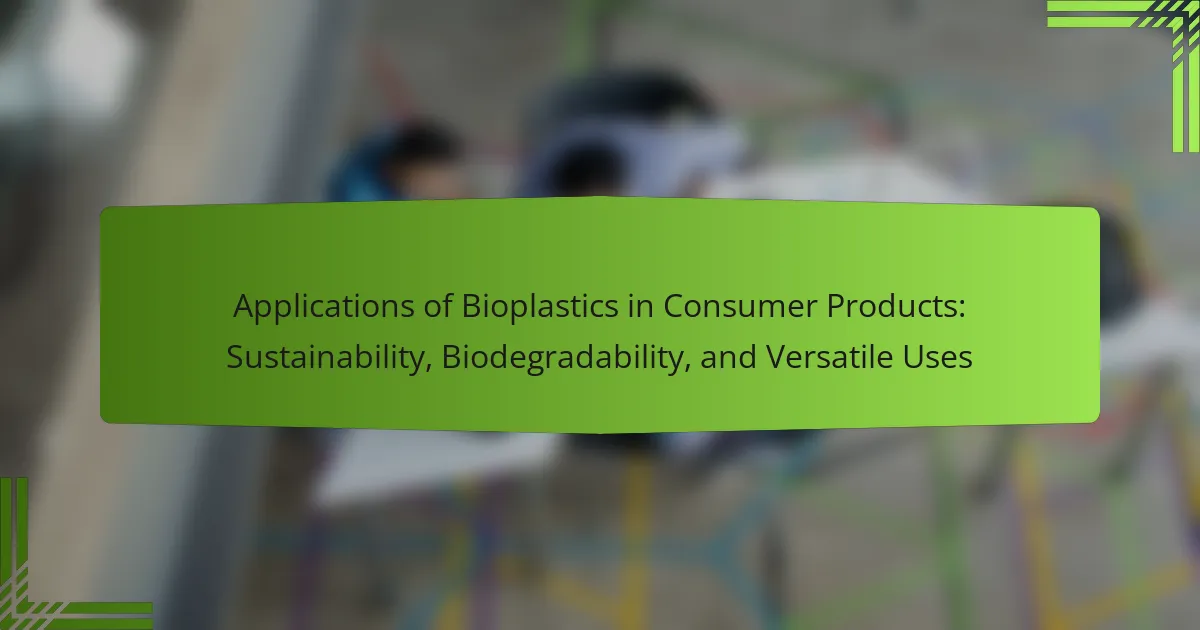Bioplastics are renewable materials designed to replace conventional plastics derived from fossil fuels, offering a more sustainable option for various consumer products. They can be categorized as biodegradable or non-biodegradable and are commonly used in packaging, utensils, textiles, and electronics. The increasing adoption of bioplastics is driven by their potential to reduce carbon emissions and environmental impact, although challenges such as higher production costs and recycling logistics persist. Additionally, the sourcing of raw materials for bioplastics raises concerns about food security and land use, necessitating further consumer education on their benefits and proper disposal methods.

What are Bioplastics and Their Role in Consumer Products?
Bioplastics are materials derived from renewable biomass sources. They are designed to replace conventional plastics made from fossil fuels. Bioplastics can be biodegradable or non-biodegradable. Their role in consumer products includes reducing environmental impact. Many bioplastics are used in packaging, utensils, and consumer goods. For instance, PLA (polylactic acid) is a common bioplastic used in food packaging. Studies show that bioplastics can significantly lower carbon emissions compared to traditional plastics. Additionally, they can help in waste reduction through compostability. The increasing demand for sustainable products drives innovation in bioplastic applications.
How are bioplastics defined in the context of sustainability?
Bioplastics are defined in the context of sustainability as materials derived from renewable biological sources. They are designed to reduce reliance on fossil fuels and minimize environmental impact. Bioplastics can be biodegradable or compostable, contributing to waste reduction. Their production often results in lower greenhouse gas emissions compared to conventional plastics. For instance, studies show that bioplastics can reduce carbon footprints by up to 70%. This makes them a viable alternative in promoting sustainable practices in consumer products.
What materials are commonly used to create bioplastics?
Common materials used to create bioplastics include starch, polylactic acid (PLA), and polyhydroxyalkanoates (PHA). Starch is derived from renewable sources like corn and potatoes. PLA is produced from fermented plant sugars, primarily corn starch. PHA is synthesized by microorganisms through the fermentation of organic materials. Other materials may include cellulose and proteins. These materials contribute to the biodegradable properties of bioplastics. Their production often results in lower greenhouse gas emissions compared to traditional plastics.
How do bioplastics differ from traditional plastics?
Bioplastics differ from traditional plastics primarily in their source materials. Bioplastics are derived from renewable biomass sources, such as vegetable fats and oils, starch, or microbiota. Traditional plastics, on the other hand, are made from fossil fuels, such as petroleum. This fundamental difference impacts their environmental footprint.
Bioplastics can be biodegradable or compostable under specific conditions. Traditional plastics typically do not break down easily and can persist in the environment for hundreds of years. Research shows that certain bioplastics can decompose in a matter of months in industrial composting facilities.
The production processes also vary significantly. Bioplastics often require less energy to produce compared to traditional plastics. This results in lower greenhouse gas emissions during their lifecycle.
In summary, the key differences between bioplastics and traditional plastics include their source materials, biodegradability, and production processes. These distinctions contribute to the growing interest in bioplastics as a more sustainable alternative.
Why is sustainability important in consumer products?
Sustainability is important in consumer products because it reduces environmental impact. Sustainable practices minimize resource depletion and pollution. They promote the use of renewable materials and energy sources. For example, bioplastics are derived from renewable biomass. This contrasts with traditional plastics made from fossil fuels. The production of bioplastics emits fewer greenhouse gases. Additionally, sustainable consumer products often have better end-of-life options. They can be biodegradable or recyclable, reducing waste in landfills. Overall, sustainability in consumer products fosters a healthier planet and supports responsible consumption.
What environmental impacts do traditional plastics have?
Traditional plastics have significant environmental impacts. They contribute to pollution in oceans and landfills. Plastics can take hundreds of years to decompose. Marine life often ingests plastic debris, leading to injury or death. Microplastics have been found in the food chain, affecting human health. Production of traditional plastics emits greenhouse gases. The extraction of fossil fuels for plastic production harms ecosystems. Recycling rates for traditional plastics remain low, exacerbating waste issues.
How do bioplastics contribute to reducing carbon footprints?
Bioplastics contribute to reducing carbon footprints by utilizing renewable resources instead of fossil fuels. They are derived from plants such as corn, sugarcane, and potatoes. This shift reduces greenhouse gas emissions during production. For instance, bioplastics can emit up to 70% less carbon dioxide compared to traditional plastics. Additionally, bioplastics can sequester carbon during their growth phase. This means they absorb carbon from the atmosphere, further mitigating climate change effects. Their biodegradability also reduces the long-term environmental impact. As they break down, they minimize pollution in landfills and oceans.
What are the benefits of using bioplastics in consumer products?
Bioplastics offer several benefits in consumer products. They are made from renewable resources, reducing reliance on fossil fuels. Bioplastics are often biodegradable, leading to less environmental pollution. Their production generally results in lower greenhouse gas emissions compared to conventional plastics. Additionally, bioplastics can reduce the carbon footprint of products. Many bioplastics can be composted, contributing to waste reduction. They also provide similar functionality to traditional plastics, allowing for versatile applications. Research indicates that bioplastics can perform well in various conditions, making them a practical alternative. These attributes make bioplastics a sustainable choice for consumers and manufacturers alike.
How do bioplastics enhance product biodegradability?
Bioplastics enhance product biodegradability by incorporating organic materials that break down more easily than traditional plastics. These materials can be derived from renewable resources, such as corn starch or sugarcane. The chemical structure of bioplastics often allows for microbial activity to decompose them effectively. Research shows that bioplastics can biodegrade in various environments, including soil and compost, within a few months to a few years. In contrast, conventional plastics may take hundreds of years to decompose. The use of bioplastics in consumer products promotes environmental sustainability by reducing plastic waste and pollution. Studies indicate that bioplastics can reduce greenhouse gas emissions during production compared to petroleum-based plastics.
What economic advantages do bioplastics offer to manufacturers?
Bioplastics offer several economic advantages to manufacturers. They can reduce production costs due to lower raw material prices. Bioplastics are often derived from renewable resources, which can be more cost-effective than petroleum-based plastics. Additionally, manufacturers may benefit from tax incentives and subsidies for using sustainable materials. The use of bioplastics can also enhance brand image, attracting eco-conscious consumers. This increased demand can lead to higher sales and market share. Moreover, bioplastics can reduce waste disposal costs due to their biodegradability. Overall, these factors contribute to improved profitability for manufacturers adopting bioplastic technologies.

What are the Versatile Uses of Bioplastics in Consumer Products?
Bioplastics have versatile uses in consumer products across various industries. They can be found in packaging materials, such as bags, containers, and films. Bioplastics are also used in disposable cutlery and plates, providing an eco-friendly alternative to traditional plastics. In the textile industry, bioplastics serve as fibers for clothing and upholstery. Additionally, they are utilized in electronics for casings and components. Bioplastics can also be found in personal care products, such as biodegradable toothbrushes and packaging. Research indicates that bioplastics can reduce carbon footprints by using renewable resources. The global bioplastics market is projected to grow significantly, reflecting their increasing adoption in consumer products.
How are bioplastics utilized in packaging solutions?
Bioplastics are utilized in packaging solutions as sustainable alternatives to traditional plastics. They are made from renewable resources like corn starch or sugarcane. These materials reduce reliance on fossil fuels. Bioplastics can be biodegradable or compostable, minimizing environmental impact. They are used in various packaging forms, including bags, containers, and films. According to a report by the European Bioplastics Association, the global bioplastics market is expected to grow significantly. This growth reflects the increasing demand for eco-friendly packaging options. Bioplastics help companies meet sustainability goals while providing functional packaging solutions.
What types of consumer products commonly use bioplastic packaging?
Bioplastic packaging is commonly used for various consumer products. These products include food containers, shopping bags, and disposable cutlery. Additionally, bioplastics are found in packaging for personal care items and electronic devices. The use of bioplastics helps reduce environmental impact. Many companies are adopting bioplastic packaging due to its biodegradable properties. This shift supports sustainability efforts across multiple industries.
How does bioplastic packaging compare to conventional packaging?
Bioplastic packaging is more environmentally friendly than conventional packaging. Bioplastics are derived from renewable resources, such as corn starch or sugarcane. This contrasts with conventional plastics, which are typically made from fossil fuels. Bioplastic packaging is often biodegradable or compostable. In comparison, conventional plastics can take hundreds of years to decompose. Studies show that bioplastics can significantly reduce greenhouse gas emissions during production. For instance, the production of bioplastics can emit up to 75% less carbon dioxide than traditional plastics. Additionally, bioplastics can reduce reliance on non-renewable resources. This makes them a more sustainable option for packaging solutions.
What role do bioplastics play in the fashion industry?
Bioplastics serve as sustainable alternatives to traditional plastics in the fashion industry. They reduce reliance on fossil fuels and lower carbon emissions. Bioplastics are often derived from renewable sources like corn starch or sugarcane. This makes them biodegradable or compostable, unlike conventional plastics. Brands are increasingly adopting bioplastics for clothing, accessories, and packaging. For instance, companies like Stella McCartney use bioplastic fibers in their collections. Studies indicate that bioplastics can significantly decrease environmental impact. The fashion industry’s shift towards bioplastics reflects a growing commitment to sustainability.
What are examples of bioplastic materials used in clothing?
Examples of bioplastic materials used in clothing include PLA (polylactic acid) and PHA (polyhydroxyalkanoates). PLA is derived from renewable resources like corn starch and is biodegradable. It is commonly used in activewear and casual clothing. PHA is produced by microbial fermentation of organic materials, resulting in a compostable fabric option. Other examples include Tencel, made from wood pulp, and bio-based nylon, which is partially sourced from renewable materials. These materials contribute to sustainable fashion by reducing reliance on fossil fuels.
How does bioplastic use in fashion contribute to sustainability?
Bioplastic use in fashion contributes to sustainability by reducing reliance on fossil fuels. Bioplastics are derived from renewable resources like corn and sugarcane. This shift decreases greenhouse gas emissions associated with traditional petroleum-based plastics. Additionally, bioplastics can be biodegradable or compostable, minimizing waste in landfills. Research indicates that bioplastics can reduce carbon footprints by up to 50% compared to conventional plastics. The fashion industry can thus lower its environmental impact by adopting bioplastics. Furthermore, bioplastics can enhance brand image as consumers increasingly prefer sustainable products. This trend encourages innovation in eco-friendly materials, driving further sustainability in fashion.
In what ways are bioplastics applied in household products?
Bioplastics are applied in household products in various ways. They are commonly used in packaging materials, such as bags and containers. These bioplastic products are often made from renewable resources like corn starch or sugarcane. Bioplastics also serve as alternatives for disposable cutlery and plates. Many cleaning product bottles utilize bioplastics for their lightweight and biodegradable properties. Additionally, bioplastics are found in personal care items, including toothbrushes and cosmetic containers. Their application extends to food storage solutions, enhancing sustainability in everyday use. Research shows that bioplastics can reduce environmental impact due to their compostability.
What types of household items are made from bioplastics?
Common household items made from bioplastics include cutlery, plates, and containers. These items are often produced using materials like polylactic acid (PLA) derived from corn starch. Bioplastic bags and food wraps are also prevalent in kitchens. Additionally, some toys and storage solutions utilize bioplastics for their eco-friendly properties. These products are designed to be biodegradable, reducing environmental impact. Research indicates that bioplastics can decompose under industrial composting conditions, further supporting sustainability efforts.
How do bioplastics in household products promote eco-friendliness?
Bioplastics in household products promote eco-friendliness by being derived from renewable resources. They are made from materials like cornstarch or sugarcane, which reduce reliance on fossil fuels. Bioplastics typically have a lower carbon footprint compared to traditional plastics. They can also be biodegradable or compostable, breaking down more easily in natural environments. This reduces plastic pollution and landfill waste. Research shows that bioplastics can decompose within months under the right conditions. In contrast, conventional plastics can take hundreds of years to break down. By using bioplastics, consumers contribute to a more sustainable and environmentally friendly lifestyle.

What Challenges and Considerations Exist with Bioplastics?
Bioplastics face several challenges and considerations. One primary challenge is their production cost, which is often higher than conventional plastics. This can limit their adoption in various industries. Additionally, bioplastics may not always biodegrade efficiently in natural environments. Some require specific conditions, such as industrial composting facilities, to break down effectively.
Another consideration is the sourcing of raw materials. The cultivation of crops for bioplastics can compete with food production. This raises concerns about food security and land use. Performance characteristics can also vary; some bioplastics may not meet the durability standards required for certain applications.
Moreover, the recycling of bioplastics poses logistical challenges. They can contaminate recycling streams if not properly sorted. Consumer awareness and acceptance of bioplastics remain limited. Many consumers are unaware of the differences between bioplastics and traditional plastics. Therefore, education is essential to promote their benefits and proper disposal methods.
What are the limitations of bioplastics in consumer products?
Bioplastics in consumer products have several limitations. They often have lower mechanical properties compared to conventional plastics. This can affect their durability and usability in various applications. Bioplastics can also be more expensive to produce. The cost is a significant barrier to widespread adoption. Additionally, they may have limited thermal stability. This restricts their use in high-temperature environments. Bioplastics can also face challenges in terms of biodegradability. Not all bioplastics decompose under typical landfill conditions. Lastly, there is a lack of recycling infrastructure for bioplastics. This complicates waste management and reduces their environmental benefits.
How do production costs of bioplastics compare to traditional plastics?
Production costs of bioplastics are generally higher than those of traditional plastics. Traditional plastics, derived from fossil fuels, benefit from established supply chains and economies of scale. In contrast, bioplastics often rely on renewable resources, which can be more expensive to process. For instance, the production cost of bioplastics can be 20% to 50% higher than conventional plastics, according to a study by the European Bioplastics Association. Additionally, bioplastics may require more complex processing techniques, further increasing costs.
What are the challenges in bioplastic disposal and recycling?
Bioplastic disposal and recycling face significant challenges. One major issue is the lack of standardized recycling systems. Many bioplastics require specific conditions for composting that are not available in typical municipal facilities. This results in bioplastics being sent to landfills instead of being properly processed. Additionally, contamination with conventional plastics complicates recycling efforts. The presence of additives in some bioplastics can hinder their biodegradability. Public awareness and education about bioplastics are also limited. This leads to improper disposal methods. Furthermore, the economic viability of recycling bioplastics is often questioned. Without financial incentives, recycling programs struggle to sustain operations.
What regulatory considerations impact bioplastics in consumer markets?
Regulatory considerations impacting bioplastics in consumer markets include compliance with environmental standards and safety regulations. Governments often require bioplastics to meet specific biodegradability criteria. For instance, the European Union has established regulations like the EU Plastics Strategy. This strategy emphasizes reducing plastic waste and promoting sustainable alternatives. Additionally, labeling requirements for bioplastics must be clear to inform consumers. The Federal Trade Commission in the U.S. mandates truthful advertising regarding environmental claims. These regulations ensure that bioplastics are both safe for consumers and beneficial for the environment.
What certifications exist for bioplastics?
Certifications for bioplastics include the Biodegradable Products Institute (BPI) certification, which ensures compostability in industrial settings. Another certification is the European Bioplastics certification, which focuses on sustainability and environmental impact. The ASTM D6400 standard certifies products as compostable in municipal and industrial facilities. The EN 13432 standard is used in Europe for assessing compostability. Additionally, the OK Compost label from TÜV Austria indicates compliance with composting standards. These certifications help consumers identify environmentally friendly bioplastic products.
How do regulations affect the adoption of bioplastics?
Regulations significantly influence the adoption of bioplastics. They establish standards for production, labeling, and environmental impact. Strict regulations can encourage manufacturers to develop bioplastics that meet sustainability criteria. For example, the European Union’s Plastics Strategy promotes the use of biodegradable materials. This creates a market incentive for companies to invest in bioplastics. Conversely, unclear or lenient regulations may hinder innovation and market growth. A study by the Ellen MacArthur Foundation indicates that clear regulatory frameworks can increase bioplastic adoption by up to 30%. Thus, regulations play a crucial role in shaping the bioplastics market landscape.
What best practices should consumers consider when choosing bioplastic products?
Consumers should consider the material’s source when choosing bioplastic products. Look for bioplastics made from renewable resources like corn or sugarcane. Check for certifications that indicate sustainability, such as ASTM D6400 or EN 13432. Evaluate the product’s biodegradability claims to ensure it meets industry standards. Review the manufacturer’s transparency regarding the lifecycle of the product. Assess the environmental impact of the production process, including energy use and emissions. Research the end-of-life options available for the product, such as composting or recycling. Lastly, compare the performance and durability of bioplastics with traditional plastics to ensure functionality.
How can consumers identify bioplastic products in the market?
Consumers can identify bioplastic products in the market by looking for specific labels and certifications. Many bioplastic products are marked with symbols indicating their biobased content. The ASTM D6400 and EN 13432 certifications indicate compostability. Additionally, consumers should check for product descriptions that mention renewable resources or biodegradability. Some brands provide transparency by listing the percentage of biobased materials used. Research shows that awareness of these labels helps consumers make informed choices. A study by the Bioplastics Industry Association highlights the importance of clear labeling for consumer recognition.
What tips can help consumers make sustainable choices with bioplastics?
Consumers can make sustainable choices with bioplastics by researching product certifications. Look for labels like ASTM D6400 or EN 13432, which indicate compostability. Choose bioplastics made from renewable resources, such as corn or sugarcane. Avoid products that are mixed with conventional plastics, as they complicate recycling. Opt for local bioplastic products to reduce carbon footprint from transportation. Educate yourself on proper disposal methods for bioplastics to ensure they are composted correctly. Support companies that prioritize transparency in their sourcing and production processes. By making informed choices, consumers can contribute to a sustainable future with bioplastics.
Bioplastics are renewable materials designed to replace traditional plastics, offering benefits such as sustainability and biodegradability. This article explores the applications of bioplastics in consumer products, highlighting their role in reducing environmental impact through lower carbon emissions and waste reduction. Key topics include the materials used to create bioplastics, their differences from conventional plastics, and their versatile uses in packaging, fashion, and household items. Additionally, it addresses challenges in production costs, disposal, and regulatory considerations, providing insights into consumer choices and best practices for selecting bioplastic products.


